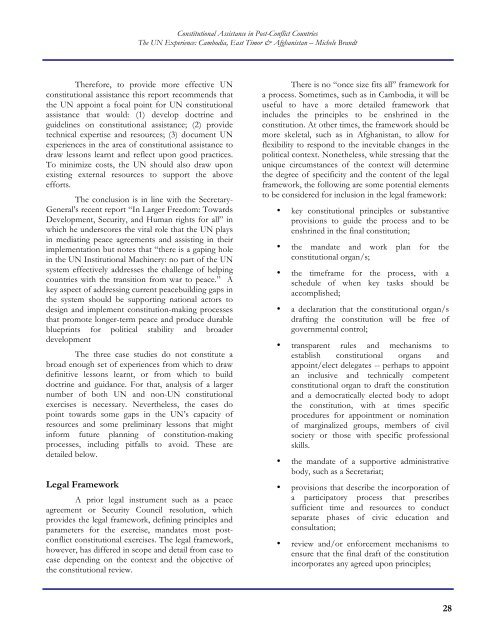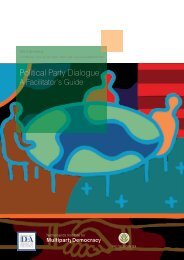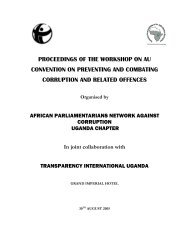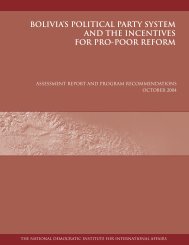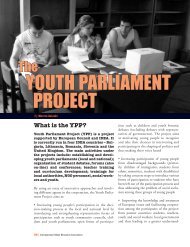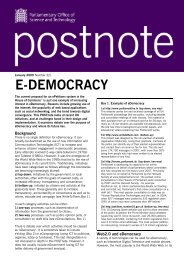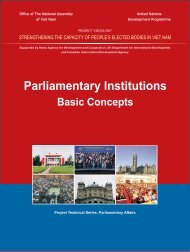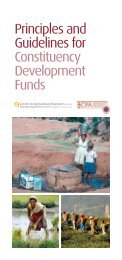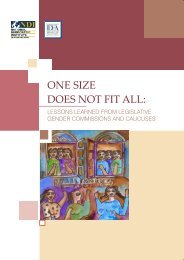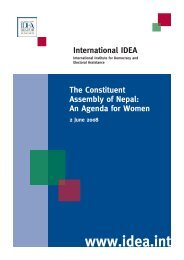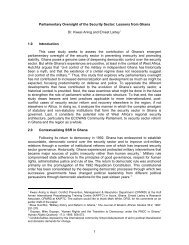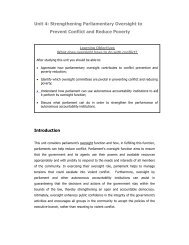Constitutional Assistance in Post-Conflict Countries The UN ...
Constitutional Assistance in Post-Conflict Countries The UN ...
Constitutional Assistance in Post-Conflict Countries The UN ...
You also want an ePaper? Increase the reach of your titles
YUMPU automatically turns print PDFs into web optimized ePapers that Google loves.
<strong>Constitutional</strong> <strong>Assistance</strong> <strong>in</strong> <strong>Post</strong>-<strong>Conflict</strong> <strong>Countries</strong><strong>The</strong> <strong>UN</strong> Experience: Cambodia, East Timor & Afghanistan – Michele Brandt<strong>The</strong>refore, to provide more effective <strong>UN</strong>constitutional assistance this report recommends thatthe <strong>UN</strong> appo<strong>in</strong>t a focal po<strong>in</strong>t for <strong>UN</strong> constitutionalassistance that would: (1) develop doctr<strong>in</strong>e andguidel<strong>in</strong>es on constitutional assistance; (2) providetechnical expertise and resources; (3) document <strong>UN</strong>experiences <strong>in</strong> the area of constitutional assistance todraw lessons learnt and reflect upon good practices.To m<strong>in</strong>imize costs, the <strong>UN</strong> should also draw uponexist<strong>in</strong>g external resources to support the aboveefforts.<strong>The</strong> conclusion is <strong>in</strong> l<strong>in</strong>e with the Secretary-General’s recent report “In Larger Freedom: TowardsDevelopment, Security, and Human rights for all” <strong>in</strong>which he underscores the vital role that the <strong>UN</strong> plays<strong>in</strong> mediat<strong>in</strong>g peace agreements and assist<strong>in</strong>g <strong>in</strong> theirimplementation but notes that “there is a gap<strong>in</strong>g hole<strong>in</strong> the <strong>UN</strong> Institutional Mach<strong>in</strong>ery: no part of the <strong>UN</strong>system effectively addresses the challenge of help<strong>in</strong>gcountries with the transition from war to peace.” Akey aspect of address<strong>in</strong>g current peacebuild<strong>in</strong>g gaps <strong>in</strong>the system should be support<strong>in</strong>g national actors todesign and implement constitution-mak<strong>in</strong>g processesthat promote longer-term peace and produce durablebluepr<strong>in</strong>ts for political stability and broaderdevelopment<strong>The</strong> three case studies do not constitute abroad enough set of experiences from which to drawdef<strong>in</strong>itive lessons learnt, or from which to builddoctr<strong>in</strong>e and guidance. For that, analysis of a largernumber of both <strong>UN</strong> and non-<strong>UN</strong> constitutionalexercises is necessary. Nevertheless, the cases dopo<strong>in</strong>t towards some gaps <strong>in</strong> the <strong>UN</strong>’s capacity ofresources and some prelim<strong>in</strong>ary lessons that might<strong>in</strong>form future plann<strong>in</strong>g of constitution-mak<strong>in</strong>gprocesses, <strong>in</strong>clud<strong>in</strong>g pitfalls to avoid. <strong>The</strong>se aredetailed below.Legal FrameworkA prior legal <strong>in</strong>strument such as a peaceagreement or Security Council resolution, whichprovides the legal framework, def<strong>in</strong><strong>in</strong>g pr<strong>in</strong>ciples andparameters for the exercise, mandates most postconflictconstitutional exercises. <strong>The</strong> legal framework,however, has differed <strong>in</strong> scope and detail from case tocase depend<strong>in</strong>g on the context and the objective ofthe constitutional review.<strong>The</strong>re is no “once size fits all” framework fora process. Sometimes, such as <strong>in</strong> Cambodia, it will beuseful to have a more detailed framework that<strong>in</strong>cludes the pr<strong>in</strong>ciples to be enshr<strong>in</strong>ed <strong>in</strong> theconstitution. At other times, the framework should bemore skeletal, such as <strong>in</strong> Afghanistan, to allow forflexibility to respond to the <strong>in</strong>evitable changes <strong>in</strong> thepolitical context. Nonetheless, while stress<strong>in</strong>g that theunique circumstances of the context will determ<strong>in</strong>ethe degree of specificity and the content of the legalframework, the follow<strong>in</strong>g are some potential elementsto be considered for <strong>in</strong>clusion <strong>in</strong> the legal framework:• key constitutional pr<strong>in</strong>ciples or substantiveprovisions to guide the process and to beenshr<strong>in</strong>ed <strong>in</strong> the f<strong>in</strong>al constitution;• the mandate and work plan for theconstitutional organ/s;• the timeframe for the process, with aschedule of when key tasks should beaccomplished;• a declaration that the constitutional organ/sdraft<strong>in</strong>g the constitution will be free ofgovernmental control;• transparent rules and mechanisms toestablish constitutional organs andappo<strong>in</strong>t/elect delegates -- perhaps to appo<strong>in</strong>tan <strong>in</strong>clusive and technically competentconstitutional organ to draft the constitutionand a democratically elected body to adoptthe constitution, with at times specificprocedures for appo<strong>in</strong>tment or nom<strong>in</strong>ationof marg<strong>in</strong>alized groups, members of civilsociety or those with specific professionalskills.• the mandate of a supportive adm<strong>in</strong>istrativebody, such as a Secretariat;• provisions that describe the <strong>in</strong>corporation ofa participatory process that prescribessufficient time and resources to conductseparate phases of civic education andconsultation;• review and/or enforcement mechanisms toensure that the f<strong>in</strong>al draft of the constitution<strong>in</strong>corporates any agreed upon pr<strong>in</strong>ciples;28


